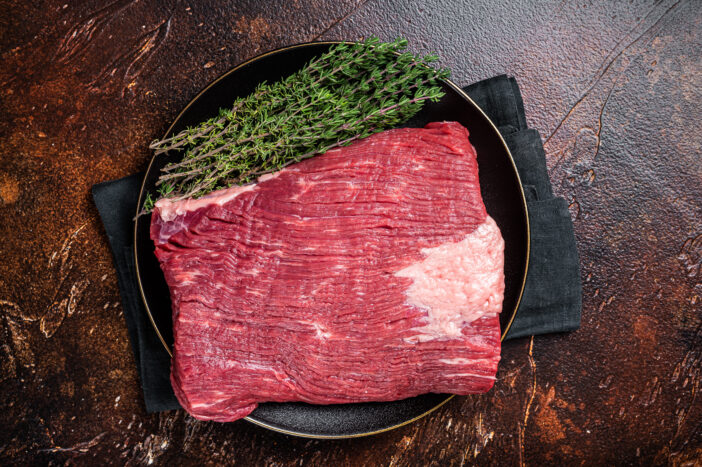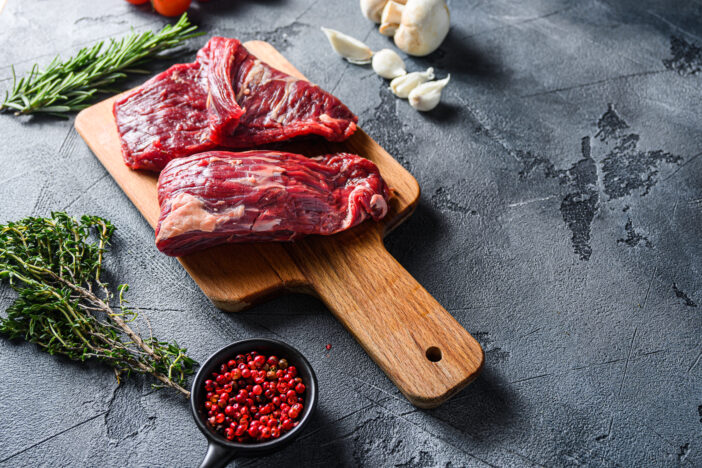7 Differences Between Flank Steak vs Brisket to Improve Your Cooking Skills
Master the flavors of flank steak and brisket: lean, quick-cooking flank steak suits grilling and stir-frying, while marbled brisket shines in slow-cooked dishes like barbecue and stews.

When it comes to mastering the art of cooking beef, choosing between flank steak and brisket can be a game-changer. Each cut offers unique flavors and requires specific techniques to unlock its full potential.
Disclosure: As an Amazon Associate, this site earns from qualifying purchases. Thank you!
Understanding the Cuts: Flank Steak vs Brisket

Diving deeper into the cuts of beef you love, let’s explore what sets flank steak and brisket apart.
Characteristics of Flank Steak
Flank steak is a lean and flavorful cut from the cow’s abdominal muscles. It’s distinguished by its flat, long shape and noticeable grain, which runs lengthwise. Since flank steak contains less fat, it’s crucial not to overcook it to maintain tenderness. Marinating can enhance flavor and juiciness, making it ideal for quick cooking methods like grilling or stir-frying. Meals like fajitas or stir-fried dishes often feature this cut due to its robust beefy taste and ability to absorb spices and marinades well.
Characteristics of Brisket
Brisket, on the other hand, is known for its rich marbling and connective tissue. Cut from the cow’s lower chest or breast, brisket requires slow cooking methods to break down the connective tissue, resulting in tender, flavorful meat. This cut is a staple in slow-cooked barbecue dishes and smoked meat recipes. When cooked properly, brisket offers a succulent texture and deep, complex flavors. It’s the go-to choice for traditional barbecue, slow-roasted dinners, and hearty stews.
Preparing Flank Steak and Brisket

Transitioning from the distinct cooking needs of flank steak and brisket, let’s focus on how to best prepare these cuts to enhance their unique flavors and textures.
Marinating Techniques for Enhanced Flavor
- Flank Steak: To introduce more tenderness and flavor into the lean cut of flank steak, opt for acidic-based marinades. Ingredients like lime juice, vinegar, or yogurt, combined with herbs and spices for at least 2 hours, can transform the meat. A popular marinade might include olive oil, garlic, lime, and cilantro, ideal for enhancing the natural beefiness of the steak.
- Brisket: Given its density and tough connective tissues, brisket benefits from a more robust marinating process. A combination of strong flavors such as soy sauce, brown sugar, and liquid smoke, marinated overnight, will penetrate deeply enhancing both flavor and texture. This not only adds to the brisket’s succulence but also complements its slow cooking method.
Trimming and Seasoning Tips
- Flank Steak: Trim any excess fat from the flank steak to ensure even cooking and reduce flare-ups during grilling. Seasoning should be generous, covering both sides of the steak with salt, pepper, and other spices like chili powder or cumin for extra kick.
- Brisket: Brisket trimming is crucial; aim to leave about 1/4-inch of fat to preserve moisture and flavor during the long cooking process. For seasoning, use a dry rub consisting of coarse salt, black pepper, garlic powder, and paprika. Rub it in thoroughly to cover all surfaces of the brisket, creating a flavorful crust that will enhance the meat’s natural flavors as it cooks slowly.
Cooking Methods for Flank Steak
Flank steak is best cooked quickly due to its lean structure. Let’s dive into the optimal ways to bring out its flavor.
Ideal Cooking Temperatures and Times
- Grill: Aim for a high heat of around 450°F to 500°F. Cooking time should be about 4 to 5 minutes per side, achieving a nice sear without overcooking.
- Oven Broiling: Set your broiler on high and place the steak about 4 inches from the element. Broil for 5 to 6 minutes per side. This method will create a crispy exterior while keeping the inside juicy.
- Skillet on Stovetop: Heat the skillet until it’s very hot; a drop of water should sizzle instantly. Cook for 3 to 4 minutes per side on high heat.
By keeping cooking times short, you’ll preserve the tenderness of the steak without it becoming tough or chewy.
- Marinate First: Since flank steak is lean, marinating for a few hours or overnight can enhance tenderness and flavor. Ingredients like lime juice, soy sauce, and garlic work well.
- Preheat Your Grill or Pan: This ensures that the meat will sear quickly, trapping in the flavors.
- Control Flare-ups: On a grill, keep a water bottle handy for any sudden flare-ups which can char the meat excessively.
- Rest the Steak: After cooking, let the steak rest for about 5 minutes. This allows the juices to be redistributed, ensuring a moist, flavorful steak when sliced.
These techniques will help you master the cooking of flank steak, emphasizing quick cooking times and high temperatures to maximize flavor and texture.
Cooking Methods for Brisket
Low and Slow: Perfecting the Braising Process
Opt for braising to turn your brisket perfectly tender. Start by searing the brisket on all sides in a heavy pot. This creates a rich base of flavors essential for a mouth-watering finish. After searing, add liquids like broth, wine, or a mix of both — they should come about halfway up the meat. Include aromatic vegetables, such as onions, carrots, and celery, for enhanced flavor. Cover and simmer at low heat in the oven or on your stovetop for several hours. The key is maintaining a low, steady temperature — aim for around 325°F. You’ll know it’s done when a fork slides easily into the meat.
Smoking Brisket for Optimal Tenderness
Smoking brisket can elevate its flavor to new heights. Start with a good rub; both salt and sugar are foundational, mixed with spices like paprika, garlic powder, and black pepper. Preheat your smoker to 225°F — a consistently low temperature is crucial for breaking down the collagen in the brisket, resulting in juicy, tender meat. Place the brisket fat side up to allow the fat to render slowly, basting the meat throughout the cooking process. Smoking time varies but generally expect about 1 to 1.5 hours per pound. Let the brisket rest for at least 30 minutes before slicing against the grain to serve.
Pairing Sides and Sauces with Flank Steak and Brisket

Flavorful sides and sauces can transform your flank steak or brisket meal into a gourmet experience. Here’s how to enhance these dishes.
Flank Steak
- Grilled Vegetables: Opt for vegetables like bell peppers, zucchini, and asparagus. Their natural sweetness complements the steak’s bold flavors.
- Cilantro Lime Rice: A bright and zesty side, cilantro lime rice adds a refreshing contrast to the rich taste of flank steak.
- Sweet Potato Fries: Offering a hint of sweetness, these fries are a crunchy, healthier alternative to regular fries.
- Caesar Salad: The creamy dressing and crisp romaine let the flavors of a well-marinated flank steak shine.
Brisket
- Cornbread: Its subtle sweetness pairs perfectly with the savory depth of brisket.
- Coleslaw: A crunchy, tangy coleslaw cuts through the fat and enriches the overall flavor.
- Roasted Brussels Sprouts: Roasting these enhances their flavor, making them a hearty complement to brisket.
- Macaroni and Cheese: Rich and creamy, this classic comfort food works well with the texture and taste of slow-cooked brisket.
Tips for Storing and Reheating

After enjoying the robust flavors of smoked brisket or the tangy zest of marinated flank steak, ensuring proper storage and reheating methods is crucial to maintain their deliciousness for later consumption.
Freezing
- Cool Quickly: To prevent bacterial growth, cool your meats quickly before refrigerating. Spread out the slices on a tray for faster cooling.
- Wrap Tightly: Use cling film or aluminum foil to wrap the meat snugly, eliminating as much air as possible, which helps prevent freezer burn if you choose to freeze.
- Separate Portions: Divide large batches into smaller portions. This speeds up the cooling process and offers convenience when you only need to reheat a single serving.
- Freezing Tips: If freezing, place the tightly wrapped meat in a freezer bag and expel any excess air. Label the bags with the date and type of meat. Properly stored, brisket and flank steak can last up to 3 months in the freezer.
Reheating
- Reheat Gently: Use low temperatures for reheating to keep the meat tender. Opt for an oven set at 250 degrees Fahrenheit or a slow cooker.
- Retain Moisture: Add a couple of tablespoons of broth or water when reheating, especially brisket, to help maintain moisture. Cover the meat to trap steam and enhance juiciness.
- Avoid Microwaving: While convenient, microwaves can unevenly reheat and toughen meats. If necessary, use low power and short intervals, stirring or flipping the meat in between.
- Check Temperature: Ensure the internal temperature reaches 165 degrees Fahrenheit to guarantee safety and quality, using a meat thermometer for accuracy.
By adhering to these strategies, you can enjoy your flank steak and brisket just as much the second time around, preserving their texture and flavor.
Frequently Asked Questions
What are the main differences between flank steak and brisket?
Flank steak is lean and flavorful, best cooked quickly on high heat to avoid toughness. It benefits greatly from marinating. Brisket, on the other hand, is a tougher cut that requires slow cooking methods like braising or smoking to break down its dense connective tissues and achieve tenderness.
How should you marinate flank steak?
Flank steak should be marinated in acidic ingredients like lime, vinegar, or wine to tenderize the meat and enhance its flavor. It’s advisable to marinate the steak for at least a few hours or, ideally, overnight for the best results.
What are the best cooking methods for brisket?
The best methods for cooking brisket are braising and smoking. Braising involves searing the brisket and then simmering it in liquid with aromatics on low heat, while smoking entails cooking the brisket with a dry rub at a low, steady temperature for several hours until tender.
Why is it important to rest brisket before slicing?
Resting the brisket allows the juices to redistribute throughout the meat, resulting in a juicier and more flavorful cut. It is crucial to slice the brisket against the grain after resting to ensure the meat is tender and easy to eat.
What are some recommended side dishes for flank steak and brisket?
For flank steak, pairing options include grilled vegetables, cilantro lime rice, sweet potato fries, and Caesar salad. For brisket, suited sides are cornbread, coleslaw, roasted Brussels sprouts, and macaroni and cheese. These sides complement the flavors and textures of each meat cut, enhancing the overall dining experience.
How should you store and reheat flank steak and brisket?
Both cuts should be refrigerated within two hours of cooking and can be stored in airtight containers for up to four days. For freezing, wrap the meat tightly in freezer-safe packaging. Reheat gently in a covered skillet or in the oven at a low temperature to maintain the meat’s moisture and texture.






